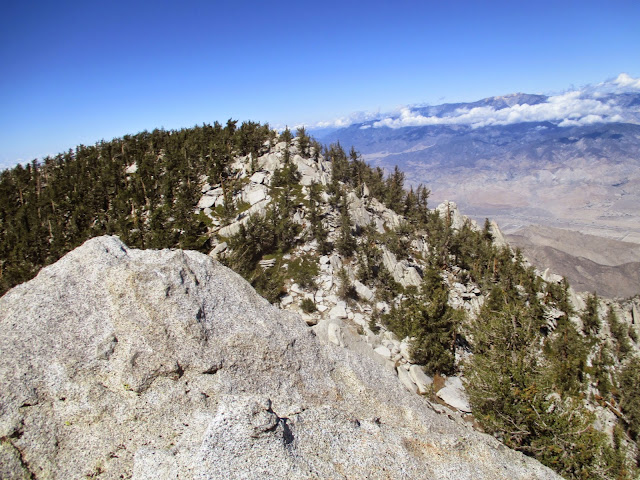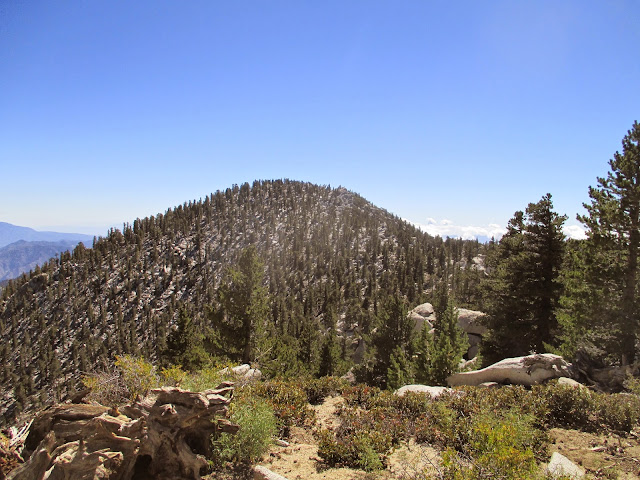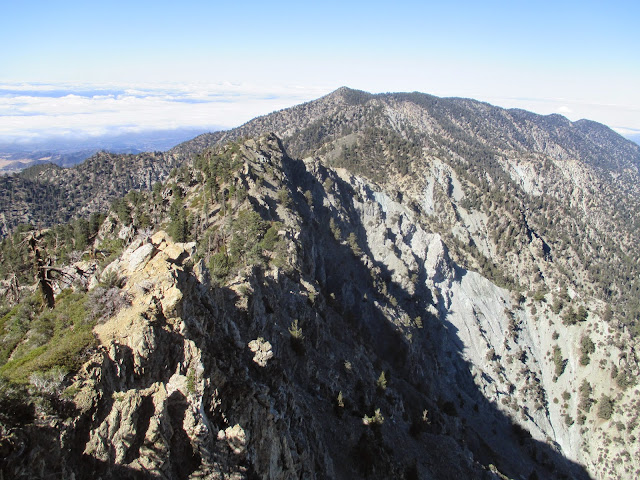HPS Star Emblem Peak
Hiked: 9/28/2014
Distance: 10.5 miles round trip on trail and cross country (estimated from topo)
Summit Elevation: 10834' (San Jacinto Peak), 10670' (Jean), 10480' (Folly), 10400' (Miller)
Prominence: 8319' (San Jacinto Peak)
Elevation Gain: 3500' (estimated from topo)
Elevation Gain (in Empire State Buildings): 2.80
Round trip time: 8 hours 50 minutes
Recommended water: 168 oz.
Parking/Fees: Parking is free, Aerial Tramway ticket $24
Difficulty: Strenuous
There are seven named summits over 10000' in elevation in the San Jacinto Mountains (counting the unofficial Shirley Peak). Summiting all seven in a single day hike from Mountain Station was proposed in July, 2013, by Hikin' Jim, who included a suggested route. The route is mostly off trail, requiring a lot of route finding and bouldering. Sean, Madison, and I set out to tackle the seven summits, but for a number of reasons, returned with only four.
We met at the Aerial Tramway and took the first tram to Mountain Station where it was a crisp 45F. After the short stop for a permit, we started down the trail. When we got about a mile down the trail, we reached the Round Valley sign where we left the trail to head up the drainage. We didn't find the use trail on up the right side of the drainage until we were on the way back, so we followed the actual drainage. It wasn't really difficult, but it was slow getting around obstacles. We followed the wrong fork and made a course correction based on my GPS. While traversing back to the right drainage, I lost the GPS. Fifteen or twenty minutes of searching proved fruitless, so we marked the spot in the drainage for another search on the way back. Now, we relied solely on maps. Soon after, we ran into Tamarack Valley campground and trail. At a three-way junction, we took the branch that followed the drainage and eventually, Miller came into view. The trail faded away in spots but we headed in the direction of the Jean saddle looking for the main trail. After picking our way through manzanita, we got the main trail and finally reached the Miller summit. We only stayed a couple of minutes before finding the east use trail to San Jacinto.
The east ridge trail to San Jacinto was pretty gentle and in good shape. There were two other hikers at the summit that left after we arrived. We took some photos and grabbed some snacks while Sean drank a beer. When he mentioned he had brought a beer on the tram, I had thought he was joking, but here it was. The wind on San Jacinto was a steady 20mph and that dropped the chill to something uncomfortable. I had gloves for bushwhacking, not warmth, and my hands were frozen, despite some chemical warmers. With potentially five summits to go, this was very concerning. We started down the ridge toward Folly and the wind was brutal, so we dropped down on the south side a little. About half way to Folly, we picked up a use trail along the ridge. Most of the trip from San Jacinto was scrmabley boulder fun. I spent a total of 30 seconds on the Folly summit before moving down out of the wind. Sean signed the register and we all studied the map for the best way to get to Newton-Drury. On the approach to Folly, I had been blowing on my hands to warm up my fingers and continued to do so as we side hilled. This led to me to hyperventilate and when combined with not eating and drinking enough left me with with some mild AMS. The headache and nausea was enough for me to abort the ambitious seven summit plan. Madison was nursing a bruised left foot and also planned to head back. This left Sean in a lurch, and he didn't want to continue alone. I forced myself to eat and drink as much as I could and Sean offered an ibuprofen, all of which eventually helped.
We retreated along Deer Springs Trail up to the Jean-San Jacinto saddle. Sean and Madison were up for hitting Jean, and by then, I had recovered enough so we left the trail again for Jean. Most of the obstacles were below the peak and the final approach to the summit was a walk up. We climbed the summit boulder and signed the register and took our final food break. Shirley and Marion Mountain were in clear view from Jean, but appeared to be too much for today. We went back to the saddle, down the main trail, then left the trail again to return along the drainage. We had some route finding problems getting through the manzanita, but eventually found the Tamarack trail. We found a use trail on the north side of the drainage that would have made it much easier on the way up. I was surprised that we found the cairns in the drainage we built on the way up. Another fruitless search for the lost GPS chewed up more time before we gave up and headed home. I was quite disappointed with my performance on the day, but glad to have learned some of San Jacinto's secrets.
Monday, September 29, 2014
Friday, September 19, 2014
Galena Peak and Galena West
HPS Star Emblem Peak
Hiked: 9/19/2014
Distance: 8.8 miles round trip on trail and cross country
Summit Elevation: 9324' (Galena), 9358' (Galena West)
Prominence: 868' (Galena)
Elevation Gain: 3360'
Elevation Gain (in Empire State Buildings): 2.68
Round trip time: 6 hours 15 minutes
Recommended water: 144 oz.
Parking/Fees: Adventure Pass
Difficulty: Strenuous
Galena Peak is the high point on the Yucaipa Ridge, a rugged line running on one side of Mill Creek opposite San Gorgonio. While dwarfed by the higher Gorgonio peaks, Galena tops out at a respectable 9324'. Sean and I started from the Vivian Creek Trailhead and quickly turned upstream in Mill Creek where the trail crossed over. At first, the grade is gentle and the rocks are small, but both change the further you go.
Heading up Mill Creek, it begins to get steeper, then large boulders and uprooted trees start to fill the canyon as it narrows. The creek itself gathered strength and you need to head up a gully on the right to bypass a high waterfall. Shortly after that, the size and frequency of the boulders changes the hike to a constant class 2. Galena towers over you as you progress. Eventually, we hit the headwall topped by the Mill Creek Jumpoff. The headwall is mostly compacted and sun-baked dirt, covered with a thin layer of loose sand and mostly unstable rocks and boulders. This makes it hard to find holds at all, especially reliable holds. The best approach is generally to stay left avoiding rockfall from the crumbling right side of the canyon. Sean stayed left, and while I started left, I began following one of the small drainages in search of traction, leading me more to the center. About half way up, Sean and I were both scrambling on all fours at 45 degree angles, both dislodging large and small landslides below us. Fortunately, we were using different lines. As we neared the top, the angle of the headwall got closer to 60 degrees while good holds remained non-existent. I realized my approach was not ideal, but it was too dangerous to try to traverse left toward Sean, and not really safe to down climb either. My best bet was to continue up. I had reached a 15' vertical section with large rocks exposed under the lip of the Jumpoff. Manzanita roots grew over the edge, some dead, some alive. I made a couple of class 3 moves to reach the manzanita roots, pulled the dead ones out of the way and crawled over the lip using the roots. Meanwhile, Sean had made it up on the left and quickly caught up to my position.
We thrashed through some shrubs to find a decent use trail heading up to Galena. The final ridge climb was steep, but not exposed or dangerous like the headwall. There was no benchmark, but we signed the register and had awesome views back down Mill Creek, the Gorgonio mountains, San Jacinto, and the San Gabriels above the low cloud ceiling. After a brief rest, we dropped our packs on Galena and completed the short hike to Galena West for better views of the jagged Yucaipa Ridge. We didn't find a benchmark or register on the unofficial Galena West. Our adventure was hardly over. We still had to get down the headwall and I knew I didn't want to go down the same way I came up. Sean and I agreed on the descent path and strategy, a combination of down climbing and dirt glissading. We staggered the descent so we would not knock rocks on top of each other. Sean went first and when he got to a safe spot, I descended to his location, then he descended further. He hit a hard patch at one point and slid a ways, leaving his hands bloody. I had a few rocks give way on me leaving me flat on my butt with some nicks on my hands and legs. It was slow going until the boulders thinned out, then we enjoyed a carefree stroll back to the car.
Would you like to know more...?
Hiked: 9/19/2014
Distance: 8.8 miles round trip on trail and cross country
Summit Elevation: 9324' (Galena), 9358' (Galena West)
Prominence: 868' (Galena)
Elevation Gain: 3360'
Elevation Gain (in Empire State Buildings): 2.68
Round trip time: 6 hours 15 minutes
Recommended water: 144 oz.
Parking/Fees: Adventure Pass
Difficulty: Strenuous
Galena Peak is the high point on the Yucaipa Ridge, a rugged line running on one side of Mill Creek opposite San Gorgonio. While dwarfed by the higher Gorgonio peaks, Galena tops out at a respectable 9324'. Sean and I started from the Vivian Creek Trailhead and quickly turned upstream in Mill Creek where the trail crossed over. At first, the grade is gentle and the rocks are small, but both change the further you go.
Heading up Mill Creek, it begins to get steeper, then large boulders and uprooted trees start to fill the canyon as it narrows. The creek itself gathered strength and you need to head up a gully on the right to bypass a high waterfall. Shortly after that, the size and frequency of the boulders changes the hike to a constant class 2. Galena towers over you as you progress. Eventually, we hit the headwall topped by the Mill Creek Jumpoff. The headwall is mostly compacted and sun-baked dirt, covered with a thin layer of loose sand and mostly unstable rocks and boulders. This makes it hard to find holds at all, especially reliable holds. The best approach is generally to stay left avoiding rockfall from the crumbling right side of the canyon. Sean stayed left, and while I started left, I began following one of the small drainages in search of traction, leading me more to the center. About half way up, Sean and I were both scrambling on all fours at 45 degree angles, both dislodging large and small landslides below us. Fortunately, we were using different lines. As we neared the top, the angle of the headwall got closer to 60 degrees while good holds remained non-existent. I realized my approach was not ideal, but it was too dangerous to try to traverse left toward Sean, and not really safe to down climb either. My best bet was to continue up. I had reached a 15' vertical section with large rocks exposed under the lip of the Jumpoff. Manzanita roots grew over the edge, some dead, some alive. I made a couple of class 3 moves to reach the manzanita roots, pulled the dead ones out of the way and crawled over the lip using the roots. Meanwhile, Sean had made it up on the left and quickly caught up to my position.
We thrashed through some shrubs to find a decent use trail heading up to Galena. The final ridge climb was steep, but not exposed or dangerous like the headwall. There was no benchmark, but we signed the register and had awesome views back down Mill Creek, the Gorgonio mountains, San Jacinto, and the San Gabriels above the low cloud ceiling. After a brief rest, we dropped our packs on Galena and completed the short hike to Galena West for better views of the jagged Yucaipa Ridge. We didn't find a benchmark or register on the unofficial Galena West. Our adventure was hardly over. We still had to get down the headwall and I knew I didn't want to go down the same way I came up. Sean and I agreed on the descent path and strategy, a combination of down climbing and dirt glissading. We staggered the descent so we would not knock rocks on top of each other. Sean went first and when he got to a safe spot, I descended to his location, then he descended further. He hit a hard patch at one point and slid a ways, leaving his hands bloody. I had a few rocks give way on me leaving me flat on my butt with some nicks on my hands and legs. It was slow going until the boulders thinned out, then we enjoyed a carefree stroll back to the car.
Would you like to know more...?
Wednesday, September 10, 2014
Eagle Peak
Hiked: 9/10/2014
Distance: 4.4 miles round trip on trail
Summit Elevation: 3226'
Prominence: 526'
Elevation Gain: 1050'
Elevation Gain (in Empire State Buildings): 0.84
Round trip time: 1 hour 50 minutes
Recommended water: 48 oz.
Parking/Fees: Free on Boulder Creek Road (Three Sisters Falls Trailhead)
Difficulty: Easy
Limited time meant I had a small choice of targets. I settled on Eagle Peak in San Diego County, another peak overlapping the Lower Peaks and San Diego Sierra Club lists. Today, my drive time would sadly double my hiking time. The easiest way to find the trailhead is to search for "Three Sisters Falls Trailhead" since the Eagle Peak trail starts in the same place.
It is a long, winding trek from the north down Boulder Creek Road to the trailhead. The last few miles are smooth dirt road passing through the Inaja Reservation. Once at the trailhead, I started down the left dirt road. In a mile or so, you come to a brown wooden post that marks the junction where the Three Sisters trail turns left and heads down into the canyon. The Eagle Peak trail continues straight ahead as a narrow single track. Along the way, you get a good look at Three Sisters Falls and today it was bone dry, a victim of the drought. The trail drops down a bit and crosses a creek, then heads up over the first of a couple of false summits. The trail mostly stays away from the sheer drop off to Boulder Creek on the left, but it is worth a short diversion to take in the views. At the summit, it had warmed up to 90+F and I went through my normal rituals. I continued past the summit a little ways to look at the spiny east ridge, then returned.
Distance: 4.4 miles round trip on trail
Summit Elevation: 3226'
Prominence: 526'
Elevation Gain: 1050'
Elevation Gain (in Empire State Buildings): 0.84
Round trip time: 1 hour 50 minutes
Recommended water: 48 oz.
Parking/Fees: Free on Boulder Creek Road (Three Sisters Falls Trailhead)
Difficulty: Easy
Limited time meant I had a small choice of targets. I settled on Eagle Peak in San Diego County, another peak overlapping the Lower Peaks and San Diego Sierra Club lists. Today, my drive time would sadly double my hiking time. The easiest way to find the trailhead is to search for "Three Sisters Falls Trailhead" since the Eagle Peak trail starts in the same place.
It is a long, winding trek from the north down Boulder Creek Road to the trailhead. The last few miles are smooth dirt road passing through the Inaja Reservation. Once at the trailhead, I started down the left dirt road. In a mile or so, you come to a brown wooden post that marks the junction where the Three Sisters trail turns left and heads down into the canyon. The Eagle Peak trail continues straight ahead as a narrow single track. Along the way, you get a good look at Three Sisters Falls and today it was bone dry, a victim of the drought. The trail drops down a bit and crosses a creek, then heads up over the first of a couple of false summits. The trail mostly stays away from the sheer drop off to Boulder Creek on the left, but it is worth a short diversion to take in the views. At the summit, it had warmed up to 90+F and I went through my normal rituals. I continued past the summit a little ways to look at the spiny east ridge, then returned.


















































